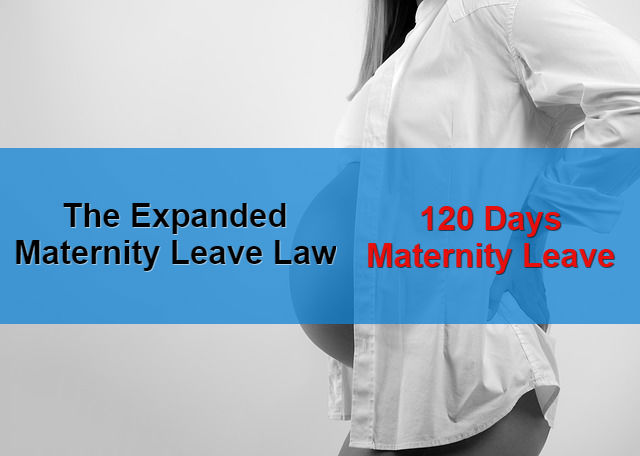When I gave birth to my first child via C-Section Delivery four years ago, the total maternity benefit that I received from the SSS was Php 39,000.
This amount was the total of my average daily salary credit multiplied by 78 days for CS delivery. For normal delivery, it is multiplied by 60 days.
In short, with the current law, female workers may only avail of 60-78 days paid maternity leave depending on the method of delivery.
For someone like me who had a complicated pregnancy and who was unable to go to work for almost one year, the Php 39,000 or the 78 days paid maternity leave was not enough.
Not only my physical condition was struggling that time, but also our financial situation. I was on PLA or prolonged leave of absence without pay from the third month of my pregnancy until two months after my delivery.
Our financial struggle would not have been as difficult if the number of paid maternity leave was longer.
Update:
The Implementing Rules and Regulations (IRR) of the 105-Day Expanded Maternity Leave Law was signed on May 1, 2019.
Under the IRR of the Expanded Maternity Leave Law (Source)
- All mothers from both the public and private sector, including those in the informal economy, will have 105 days of paid maternity leave regardless of the mode of delivery, civil status, legitimacy of the child, and employment status.
- Of the 105 days, 7 days may be transferred to the father of the child.
- Solo working mothers would also get an additional 15 days for a total of 120 days of paid maternity leave.
- The law also allows working mothers to extend their leave for another 30 days but without pay.
- In cases of miscarriage or emergency termination of pregnancy, 60 days of maternity leave with full pay shall be granted to female workers.
- Working mothers who gave birth on March 11, 2019 or after are entitled to the full benefits of the Expanded Maternity Leave Act.
Sen. Risa Hontiveros, the principal author and sponsor in the Senate of The Expanded Maternity Leave Law, said she was happy that the IRR was already signed and approved.
“I welcome this development as this ensures the full implementation of the law and that all women will benefit from the measure,” said Sen. Hontiveros in a statement.
Expanded Maternity Leave Law to Boost SSS Benefit Payouts
According to SSS president and chief executive, Aurora C. Ignacio, the SSS have recorded an increase of 12.6 percent or 36,550 female members more who availed themselves of the benefit in 2018 compared to that of the previous year.
They are expecting that these disbursements will continue to increase after the implementation of the 105-day Expanded Maternity Leave Law which has already been signed on Labor Day, May 1, 2019.
“The SSS is motivated to continuously develop its benefit programs to provide more meaningful assistance to its members. We recognize the needs of mothers and their newborn babies. We hope that through the Extended Maternity Leave Law, women workers may be able to fully enjoy their rights to health and decent work,” said Ignacio. (Source)
Watch this Expanded Maternity Leave Law view by GMA News Unang Balita report.
The Expanded Maternity Leave Law of 2017
The Expanded Maternity Leave Law of 2017 or Senate Bill 1305, which was authored by Senator Risa Hontiveros, hopes to make a difference by giving us more paid leaves, more time to recover from the rigors of pregnancy and childbirth, and more time to care for our newborns.
This bill states that all covered female workers in government and the private sector, including those in the informal economy, regardless of civil status or the legitimacy of her child, shall be granted 120 days maternity leave with pay and an option to extend for an additional 30 days without pay.
- Of the 120 days maternity leave, 30 may be transferred to other caregivers including the child’s father (whether or not he’s married to the female worker/child’s mother), the female worker’s spouse, common-law partner, current partner sharing the same household, and relative up to the fourth degree of consanguinity.
- A written notice must be provided to the employers of the female worker and alternative caregiver.
- The additional maternity leave of 30 days, without pay, can be availed of, at the option of the female worker.
- A written notice must be provided to the head of the agency (employer or the SSS) at least 45 days before the end of her ordinary maternity leave.
Meanwhile, female workers who qualify as solo parents under Republic Act No. 8972, or the Solo Parents’ Welfare Act, shall be granted 150 days maternity leave with pay.
A. Maternity Leave for Female Workers in the Public Sector
A maternity leave of 120 days with full pay will be granted to any pregnant female worker in the government service, regardless of employment status in NGAs, LGUs, GOCCs, or SUCs.
The daily maternity benefit will be based on the average weekly or regular wages of the worker, regardless if the delivery was normal or caesarean.
B. Maternity Leave for Female Workers in the Private Sector
A maternity leave of 120 days with full pay will be granted to any pregnant female worker in the private sector who has paid at least three monthly contributions in the twelve-month period immediately preceding the semester of her childbirth or miscarriage.
How is it computed?
The daily maternity benefit shall be computed based on the average monthly salary credit, for 120 days, regardless of whether she gave birth via caesarian section or natural delivery.
Click here to read: How to Compute SSS Maternity Benefit (with examples)
The maternity benefit of female workers in the private sector is subject to the following conditions:
- The female worker shall have notified her employer (if employed) or the SSS directly (if voluntary or self-employed) of her pregnancy and the probable date of her childbirth.
- The full payment shall be advanced by the employer (for employed workers) within 30 days from the filing of the maternity leave application.
- The SSS shall immediately reimburse the employer of 100% of the amount of maternity benefits advanced to the female worker by the employer upon receipt of satisfactory and legal proof of such payment.
- If a female worker should give birth or suffer a miscarriage without the required contributions having been remitted for her by her employer to the SSS, or without the latter having been previously notified by the employer of the time of the pregnancy, the employer shall pay to the SSS damages equivalent to the benefits which said female member would otherwise have been entitled to.
C. Maternity Leave Benefits for Women in the Informal Economy and Voluntary Contributors to the SSS.
Female workers in the informal economy, whether married or unmarried, are entitled to maternity leave benefits if they have remitted to the SSS at least 3 monthly contributions in the 12-month period immediately preceding the semester of her childbirth or miscarriage.
D. Maternity Benefits for Female Workers Who are Non-members of the Social Security System.
Female workers who are NOT members of the Social Security System shall be governed by Philhealth Circular No. 15 022-2014 or the “Social Health Insurance Coverage and Benefits for Women About to Give Birth”.
E. Maternity Leave for Female National Athletes.
If a female national athlete becomes pregnant, she shall go on maternity leave and continue receiving her allowance and be entitled to the same benefits while on maternity leave prior to childbirth and up to 6 months after, unless she can resume sooner as advised by her physician.
When to avail of the Maternity Leave
As stated in this bill, the enjoyment of maternity leave cannot be deferred but should be availed of by the qualified female worker either before or after the actual period of delivery in a continuous and uninterrupted manner, not exceeding 120 calendar days.
The maternity leave shall be granted to female workers in every instance of pregnancy or miscarriage, regardless of frequency.
Paternity Leave
Republic Act No. 8187, also known as the Paternity Leave Act of 1996, grants paternity leave of 7 days with full pay to all married male employees in the private and public sectors.
The Paternity leave of seven days shall be non-cumulative and strictly non-convertible to cash. The same may be enjoyed either in a continuous or in an intermittent manner by the employee on the days immediately, before, during, and after the childbirth or miscarriage of his legitimate spouse. Said leave shall be availed of not later than 60 days after the date of the child’s delivery.
This Paternity leave is granted to enable the married male employee to effectively lend support and assistance to his wife in her period of recovery and in the nursing of their newly born child.
An Update to the Senate Bill 1305
The Senate Bill 1305 or the “Expanded Maternity Leave Law of 2017” consolidates various Senate Bills filed at the Senate of the Philippines.
This bill has been approved on third reading with 22 senators voting in favor of the measure on March 8, 2017, but the parallel bill for the said measure is still pending in plenary at the House of Representatives.
A harmonized or common bill should be passed by both Senate and the House of Representatives before they, as one Congress transmits the harmonized bill to the Office of the President for approval. A bill only becomes a law once the President signs it into law; or in some cases, transmitted bills lapses into law if not acted upon by the President within 30 days from receipt. (Source)
We will update this article as soon as an update is released for the Expanded Maternity Leave Law of 2017.
Click here to read:
- SSS Maternity Benefit: Requirements and Application
- How much can you expect from your SSS Maternity Benefit?
- What’s NEW with the Expanded Maternity Leave Bill







[…] Click here to read: Expanded Maternity Leave Law Update -120 days Maternity Leave […]